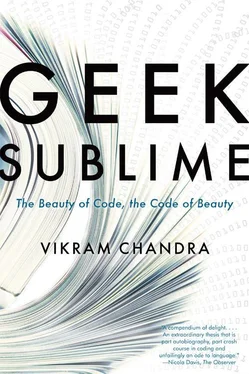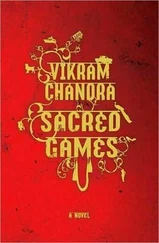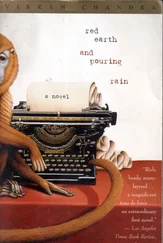It was perhaps the multitude of viewpoints and ideologies attempting to speak to each other and against each other in Sanskrit that intensified its grammarians’ search for even more exactness. Beginning in the fourth century BCE and culminating in the eighteenth century, an effort was made to create a shastric or scientific Sanskrit that could “formulate logical relations with scientific precision.” 30In this specialized, condensed Sanskrit, the sentence “Caitra goes to the village” would be rephrased as “There is an activity which leads to a connection-activity which has as Agent no one other than Caitra, specified by singularity, [which] is taking place in the present and which has as Object something not different from ‘village,’”
The sentence “Out of friendship, Maitra cooks rice for Devadatta in a pot, over a fire” would be broken down into:
(1) An Agent represented by the person Maitra;
(2) An Object by the “rice”
(3) An Instrument by the “fire”
(4) A Recipient by the person Devadatta
(5) A Point of Departure (which includes the causal relationship) by the “friendship” (which is between Maitra and Devadatta);
(6) The Locality by the “pot” 31
The shastric version of the original sentence would therefore be something like:
There is an activity conducive to a softening which is a change residing in something not different from rice, and which takes place in the present, and resides in an agent not different from Maitra, who is specified by singularity and has a Recipient not different from Devadatta, an Instrument not different from … 32
and so on.
So the shastric thinkers tried to create a low-level version of Sanskrit, a counterpart to assembly code. In fact, Rick Briggs, a NASA specialist in artificial intelligence, points out that this decomposition of natural language is very similar to what computer programmers do when they attempt to represent knowledge in semantic nets, which use “triples” to embody logical relations: “cause, event, friendship; friendship, object1, Devadatta; friendship, object2, Maitra; cause, result, cook; cook, agent, Maitra …” and so on. Briggs writes:
It is interesting to speculate as to why the Indians found it worthwhile to pursue studies into unambiguous coding of natural language into semantic elements. It is tempting to think of them as computer scientists without the hardware, but a possible explanation is that a search for clear, unambiguous understanding is inherent in the human being. 33
The extraordinarily logical nature of Sanskrit, the fact that “we are lakṣaṇaikacakṣuṣka , solely guided by rules,” that “correctness is guaranteed by the correct application of rules,” that you can generate a grammatically correct word or phrase you need by applying these rules — all this leads to a strong similarity between it and modern programming languages. The Ashtadhyayi itself is replete with features that resemble modern programming constructs: recursion; multiple inheritance (a rule based on other rules acquires all the properties of the parent rules); context-sensitive and context-free rules; conflict resolution for rules; string transformations; ordered operations; a metalanguage; and so on. 34Programmers who know Sanskrit sometimes claim that it would make the perfect programming language, endlessly rigorous and endlessly flexible. 35
The inheritors of the Paninian tradition were deeply concerned with the relationship between language, meaning, and function: How is meaning transferred? How is it understood? Does language impel action? These questions became particularly urgent when these theorists were confronted by belletrist poetry written in the unchanging formal language of science and scripture. Over the centuries, Sanskrit developed a flourishing culture of kavya —poetry — and so the philosophers of language had to engage with beauty. Their investigations took them inescapably toward considerations of aesthetics: How was beauty produced in language? How does beauty affect or influence the reader, the viewer? Like programmers with their discussions of the “eloquence” of code, the classical Indian theorists tried to think about the effects that flowed from formal-language texts and went beyond the purely functional.

Until about the mid-ninth century CE, the thinkers of the Sanskrit cosmopolis who were interested in the nature and epistemology of literary beauty concerned themselves with the formal qualities of texts; they thought of poetry as language made beautiful through the operations of certain constructions: simile, metaphor, metonymy, double entendre or puns, alliteration, sound, rhythm, and so on. These figures were alamkaras , ornaments, which beautified language in much the same way that jewelry embellished a body. Some scholars ascribed a more central role to riti or “style,” to guna s or “qualities” such as ojas , “strength” or “vigor” (achieved, for example, through the use of long compounds in prose); prasada , clarity or lucidity; samata , the uniformity of diction; sukumarata , softness or delicacy; etcetera. These qualities, the adherents of riti argued, produced beauty, which was in turn heightened by figures of speech. Whatever specific emphases the Indian aestheticians may have preferred in their writings on beauty, all of these early scholars were formalists; poetics itself was alamkara-shastra , the study of ornamentation. Their critical methods were heavily particularistic, and they therefore produced exhaustive catalogs of alamkara s and their effects, of the varieties and subvarieties of linguistic structures used by writers.
The theorist Anandavardhana (820–9 °CE) caused an upheaval among these alamkarikas with his treatise Dhvanyaloka (The light of suggestion). Until Anandavardhana, Indian philosophers of language had accepted two main modes of signification through which language conveyed meaning: abhidha , the literal or the denotative, and lakshana , the metaphorical and figurative, the connotative. Anandavardhana proposed that poetic language set yet another semantic function into play: suggestion. The stock example used to illustrate the workings of suggestion in mundane language is the simple sentence, “The sun has set.” An eleventh-century theorist wrote:
The denoted meaning of a word is one and the same for all persons bearing it; so that it is fixed and uniform; the denoted or directly expressed meaning of the words “the sun has set” never varies (is fixed), while its suggested meaning varies with the variation in such accessory conditions as the context, the character of the speaker, the character of the person spoken to, and so forth. For instance, the words “the sun has set” suggests (1) the idea that “now is the opportunity to attack the enemy” (when they are addressed by the general to the king);—(2) “that you should set forth to meet your lover” (when addressed by the confidant to the girl in love)
and so on until “(10)—‘my love has not come even today’ (when spoken by an impatient girl waiting for her beloved’s return from a journey); thus, in fact, there is no end to the number of suggested meanings.” 36
Anandavardhana’s assertion was that in literature, suggestion or vyanjana added layers of meaning to the text that were not apparent in the denotative or figurative content of the language; vyanjana is derived from the root vi plus anj , “to reveal, manifest”— vyanjana therefore manifests a multitude of meanings within the reader. And, Anandavardhana argued, when “sense or word, subordinating their own meaning, suggest that [suggested] meaning”—that is, when the denoted and figured meaning becomes less important than the manifested, unspoken meaning — that poetry becomes “the type of poetry which the wise call dhvani. ” 37 Dhvani derives from dhvan , “to reverberate”; dhvani poetry therefore causes an endless resonance within the reader—“the suggested sense [flashes] forth in an instant in the minds of intelligent auditors who are averse to the literal sense and in quest of the real meaning.” 38So the echoes of dhvani are available only to those who are capable, who are alert to the possibilities of poetry. Dhvani is “not understood by the mere knowledge of grammar and dictionaries. It is understood only by those who know the true nature of poetic meaning.” 39 Dhvani is “the soul of poetry.” 40
Читать дальше













